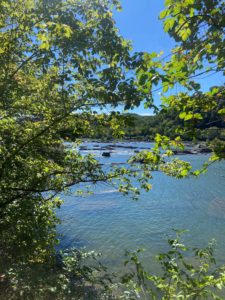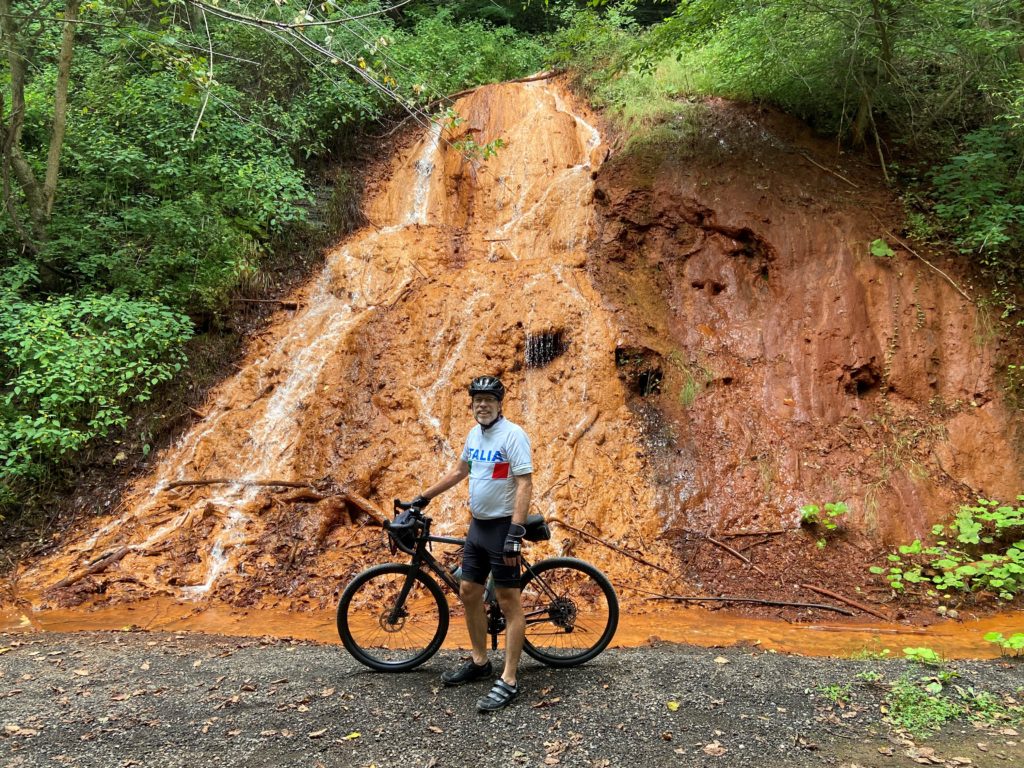I’m not the kind of guy who keeps a long bucket list of vacation goals or life-threatening challenges. But for the past few years I’ve talked about riding my bike from the outskirts of Pittsburgh to Washington, D.C., a 335-mile ride that includes a long, steady incline up one side of the Eastern Continental Divide and down the other. This summer, I finally made the trip.
You could call it a working vacation of sorts. I thought of it as a retreat with mileage.
Almost the entire route was away from cars and away from cities. Most of the time and most of the miles were on gravel paths often strewn with potholes, tree roots, and the occasional mud puddle. Riding on the Great Allegheny Passage (GAP) trail and the Chesapeake & Ohio (C&O) Canal trail, we passed through small towns that once played big roles in U.S. history. Towns like Hancock, Maryland, whose residents fought off a siege by General Stonewall Jackson, and Harper’s Ferry, West Virginia, where John Brown failed to inspire a slave uprising in 1859 but lit the fuse that became the Civil War.
Gravel provided its own soundtrack to the trip. At times it crackled and crunched under our tires, like popcorn muffled in the microwave. But patches of dirt or dried mud introduced a quiet note, so that the crunch gave way to silence for brief moments. No doubt the wildlife in the area were well alerted to our presence, but deer, rabbits, hawks, blue herons, a black snake, and one enormous and rather surly snapping turtle still crossed our path. Or more accurately, we crossed theirs.

The author's view on his summer bike ride. (Submitted photo)
The trail took us along three rivers: The Youghiogheny, the Casselman and the majestic Potomac. Rivers were the lifeblood of our young country. Towns grew up along their banks. Goods were transported on them. The C&O Canal started as the brainchild of George Washington, who sought a way to bypass the falls and rapids of the Potomac and bring goods west. It was dug by 35,000 workers, mostly immigrants, but its utility was challenged even as it was being built by the arrival of the railroad. We would occasionally hear a train roaring west on tracks paralleling the canal, the clatter of wheels on rails a taunting reminder of who won that race.
What was most memorable, however, was simply being immersed in nature for hours at a time. The rhythm of the pedals and the crunch of the gravel provided a soundtrack to the canopy of trees and the lush microclimates that we rode through. There was beauty everywhere. Sunlight streaming through the trees, wild flowers growing on the banks of the canals. The rivers — changeable, moody, sparkling one minute and then seething and tumultuous the next.
The Japanese have a term: “Shinrin-yoku,” or “forest bathing.” It describes that peace which comes from simply being quiet amid the trees, like walking the garden paths of a monastery. There is a peace that settled over me riding down those trails. I was in the moment, legs and bike pushing forward in a steady rhythm that said, “be where you’re at; do what you’re doing.” It is motion that is conducive to prayer, but particularly the type of prayers we often overlook: those of praise and thanksgiving.
As the miles mounted and the days passed, the beauty drove out other concerns. I may be a news junkie, but for a week, I kicked the habit. Looking at my news feeds didn’t interest me. I ignored news channels on television. I stopped prowling my emails.

The author at a spot marking the Eastern Continental Divide in Pennsylvania during his 335-mile bike ride from Pittsburgh to Washington, D.C. (Submitted photo)
“Holidays and vacations can help to balance activity with contemplation, haste with more natural rhythms, noise with the heralding silence of peace.” St. John Paul II said that. He was an outdoorsman, a skier, a hiker, a swimmer. I think he would have appreciated my ride and understood its impact.
Activity and contemplation. Haste with natural rhythms. Noise with peace. The whirr of the wheels. The smells and sights of nature. Feeling for a short while like I’m one with the bike and one with the nature that I am spinning through and a part of.
There were nine others on the trip with me. We had all signed up with Wilderness Voyageurs, a company that specializes in multi-day bike trips around the country. Strangers when we set out, we all counted ourselves friends at the end. Each of us had his or her own reason for coming. Yet we bonded in the experience, hearing one another’s stories as we rode the trail or shared a meal.
Certain themes stood out: the challenge of friendships; the demands of work; the questions that come with retirement. In a sense, it felt like we were all finding our way, our path. But for six days, our quest was simply to be, and to savor the goodness of the Lord’s creation.

